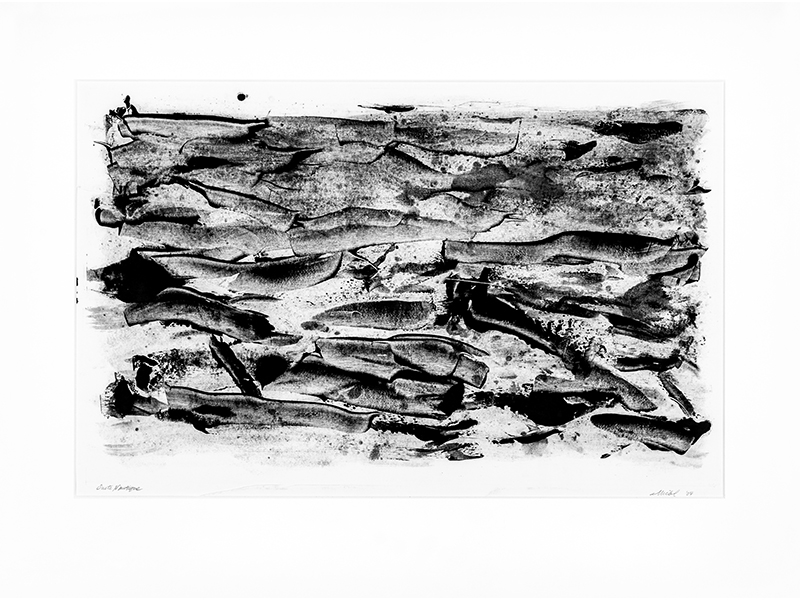The Imagining Worlds of Michel Goldberg
by Dominique Nahas
This exhibition attests to artist Michel Goldberg’s status as a virtuoso in the monotype printmaking process. The artist has trained his eye and mind throughout countless studio hours, of self-observation, tenacious practice and experimentation. Goldberg’s artworks are the result of a balancing of spontaneous production with preconceived plans, of equipoise between will and instinct. Along with all of this is the consensus that Goldberg as a master artist is simply gifted with innate, remarkable legerdemain. He somehow manages to magicalize each of his surfaces in different ways, transmuting them, causing a cascade of sensations to emanate from his prints. He can create imprinted surfaces that are evanescent and smoke-like or water-like to the perceptible world that it really feels like vapor, smoke, cloud-like wisps, water, something so fleeting, intangible, something that slips away from your senses. The artist’s imagery can appear so soft-like it appears to be held together with marks made more by the delicate fillagree-flicks and blotches of fingers holding a water-coloring brush than by a mechanism involving a plate. He evokes for example the presence of eternity and of the fugitive in a work such as Suite Nautique #2. Here we are immersed in a small ecstatic work, suffused within a dense dream-like pictorial world, a miniature cosmos of proliferation and expansion, that sustains luminous dissolving and absorbing marks and brushstrokes. Floating apparitions that flicker with what French phenomenologist Gaston Bachelard would term a quality of “intimate immensity” that holds us in a moment of rapture, in a suspended moment of prolonged presentness. In Terra Incognita #3 we further see the range of effects Goldberg is capable of producing. In this magisterial work the artist holds in dialectical tension of opposite universes fitted as one. We see and feel the uneasy co-existence of hard impacted guttural materiality held against softly disperse translucence. Such is the nature of the poetic imagination of Goldberg’s meditation on space, time, and memory: the physical and the metaphysical converge.
Michel Goldberg’s acute sensitivity to surfaces and to the haptic are derived not only from his involvement with printmaking but also from his long commitment with the one-on-one challenges of shaping and shapeshifting differently realized three dimensional forms, sculptures that are constructed out of steel using mig welding or involve hand-chiseling, shaping and smoothing stone such as Italian Alabaster. The term complexity takes into account the positive ambiguity, the unsettledness, that Goldberg’s prints embody. That is to say the condition of complexity involves a range of contradictory impulses and mixed-intentions, moods or suggestions that congregate and congeal in each work. This differently sided intake makes Goldberg’s oeuvre, as a whole, deeply satisfying as it appears to be endlessly, poetically suggestive and open-ended. The artist’s daring, desire and capacity to embody through the medium of the monotype his mental, visual, sensation-filled and emotional memories in his work, and as his work is remarkable.
The immersive, apparitional quality of Michel Goldberg’s print work and his drawings haunts us with their intensity. A radical sense of interiority in terms of mood saturates each work. The sensations that the viewer feels, in conjunction with the variety of feelings that Goldberg works off of (or plays with, with great intensity and focus) are moving. The artist has made it his passion to work within a narrow methodology and this has required considerable determination; in the end what we see as viewers is the result of Goldberg’s devotion to the explorations of paper and to the tonal handling of inks and to a limited number of structured outlines or forms derived from using object-trouvés in the form of natural or artificial detritus. Additionally, there is a palpable oneiric quality to his work as Goldberg’s somber tonalities bespeak of a quest for introspection and rumination.
Several of the artist’s titles bear witness to his questioning, reverie-filled and exploratory states of mind: Terra Incognita, Jardin des Rêves, Suite Nautique, Station de Voyageurs. Goldberg treats each surface with such radical intensity that his artworks are open invitations for the eye to dwell, circulate and to linger with each work. His pictorial surfaces are alive with activity: we see his applied, nearly miniaturized skeins of paint, his staccato stippling of tiny tremulous brush strokes as constitutive elements suggestive of overlaid handwritten secret alphabets. The artist’s painterly marks vacillate ambivalently between appearing to be self-effacing, mechanical and constructive at times; at other times they give the appearance of expressive randomness, of idiosyncratic, ostentatious deliberateness. A rigorous, visual poetry of interiority pervades. In his artist’s notes Michel Goldberg writes: “Working in the studio is a mysterious journey into the unknown…it is totally personal, self—motivated and frankly, at times, scary. There is no guaranteed outcome at the end of these working sessions. It is a trip into your psyche which at times, allows one a glimpse of what the soul has kept hidden…”
Dominique Nahas is an independent curator and critic specializing in contemporary art. He is based in Brooklyn and Chatham, NY. A former museum director and curator, Nahas is the author of numerous articles, reviews and books. He is a member of the fine arts faculty at Pratt Institute where he teaches critical theory, art history and professional practices.


